|
Getac PS236
Ultra-rugged Windows Mobile PDA with integrated GPS, altimeter, e-compass, camera, hi-res display for all sorts of GIS surveying and other GPS/mapping-based applications
(by Conrad H. Blickenstorfer -- (view review as PDF)
On September 8, 2009, Getac announced an addition to its comprehensive line of rugged mobile computing solutions consisting of rugged notebook, tablet and handheld computers. The Getac PS236 is an ultra-rugged GPS-enabled handheld computer literally brimming with advanced technology. Complementing the Getac PS535F handheld introduced in March of 2009, the new model represents a top-of-the-line handheld GIS surveying and mapping device that provides extra performance and ruggedness for the most demanding field applications. It's an attractive design with a handy keypad for rapid data entry, and will compete directly with the ultra-rugged PDA offerings from the likes of Trimble, TDS and Juniper Systems.
The hardware
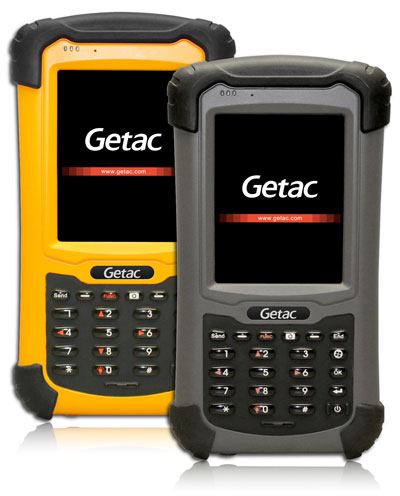 The PS236 platform is a fully rugged PDA based on the Windows Mobile platform. It was conceived to bring general purpose PDA functionality to field-based applications, with special emphasis on GPS/GIS applications, ruggedness and maximum performance. With a footprint of 3.5 x 7.0 inches and a thickness of an inch and a half, the device is too large for most pockets but small and handy enough to carry around. Weight is a bit over a pound, including battery. What sets the PS236 apart from most rugged Pocket PC-style devices is its integrated high-sensitivity GPS receiver and state-of-the-art technology. The PS236 platform is a fully rugged PDA based on the Windows Mobile platform. It was conceived to bring general purpose PDA functionality to field-based applications, with special emphasis on GPS/GIS applications, ruggedness and maximum performance. With a footprint of 3.5 x 7.0 inches and a thickness of an inch and a half, the device is too large for most pockets but small and handy enough to carry around. Weight is a bit over a pound, including battery. What sets the PS236 apart from most rugged Pocket PC-style devices is its integrated high-sensitivity GPS receiver and state-of-the-art technology.
From a tech perspective, Getac set the bar pretty high with the latest version of its PS535F handheld, and the PS236 follows suit in that tradition. On the display side, it has a 3.5" touchscreen display with full VGA 480 x 640 pixel resolution. That translates into 228dpi (dots per inch), considerably sharper even than the Apple iPhone's 162dpi display. Combined with transflective sunlight-readable display technology, the very high resolution makes for excellent viewing quality of graphic-intensive files and detailed maps, even in bright daylight or snowy conditions.
Like the smaller PS535F, the new PS236 comes with a built-in 3-megapixel auto-focus camera, an altimeter and an E-compass. These new features are meant to let field-based users capture a much richer, expanded range of field data on-site. Combined with the PS236's integrated SiRFstar III GPS and Getac's proprietary geotagging application, this rugged Getac handheld offers plenty of the advanced location-based systems functionality required in GIS applications, search-and-rescue operations, and similar deployments.
Thanks to its integrated altimeter and E-compass, the PS236 handheld GPS PDA can provide accurate latitude, longitude, and altitude data as well as the ability to generate directional relations between the unit's position and that of a target. 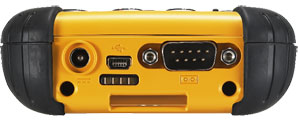 The built-in camera enables instant visual data capture on location and its resolution and quality are high enough so that taking a (fragile) camera along may not be necessary. Wireless connectivity options (including HSDPA WWAN) can be used to connect the PS236 to a GIS server and instantly transmit or process data in the field. There are a lot of tools built into this unit that, combined with the proper software, make entirely new applications possible, applications that in the past either required multiple devices or simply were not available in the field. The built-in camera enables instant visual data capture on location and its resolution and quality are high enough so that taking a (fragile) camera along may not be necessary. Wireless connectivity options (including HSDPA WWAN) can be used to connect the PS236 to a GIS server and instantly transmit or process data in the field. There are a lot of tools built into this unit that, combined with the proper software, make entirely new applications possible, applications that in the past either required multiple devices or simply were not available in the field.
Unlike the smaller PS535F that is powered by a 533MHz Samsung S3C2450 processor, the new PS236 uses Marvell's PXA310. The PXA310 is part of Marvell's PXA3xx family of application processors that offer higher performance as well as lower power consumption than the predecessor PXA255 and PXA270 chips used in millions of handhelds. Capable of running at clock speeds up to 806MHz, the PXA310 provides excellent speed, hardware video acceleration, DRM security and combines them with low-power modes ad the ability to dynamically adjust voltage and frequency for optimal battery life.
The PS236 also offers plenty of storage in the form of 4GB of onboard NAND Flash that can be complemented with an additional 8GB through an SDHC card slot.
Windows Mobile
The Getac PS236 comes with Windows Mobile 6.1 (either "Classic" or "Professional"). Compared to earlier versions of Windows Mobile, Windows Mobile 6.1 offers instant messaging-like texting, improved browsing, simpler email and Bluetooth setup, security enhancements, and an improved Home screen interface. Anyone who has ever used a Windows Mobile device will instantly be familiar with the rich functionality and the mobile versions of the major Microsoft Office applications (Word, Excel, Powerpoint, Outlook, Internet Explorer). Operations is via stylus, touch, a five-way navigation stick, and four hardware application buttons.
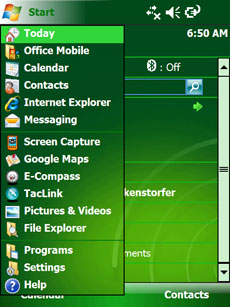 Why did Getac choose Windows Mobile instead of Windows CE .NET or Windows CE 5.0 or 6.0 with their more industrial look and feel and functionality? These days, Microsoft differentiates between Windows Embedded CE and Windows Mobile. Windows Embedded CE is a scalable 32-bit OS designed for intelligent devices ranging from enterprise tools such as industrial controllers, communications hubs, and point-of-sale terminals to consumer products such as cameras, phones, and home entertainment devices. Why did Getac choose Windows Mobile instead of Windows CE .NET or Windows CE 5.0 or 6.0 with their more industrial look and feel and functionality? These days, Microsoft differentiates between Windows Embedded CE and Windows Mobile. Windows Embedded CE is a scalable 32-bit OS designed for intelligent devices ranging from enterprise tools such as industrial controllers, communications hubs, and point-of-sale terminals to consumer products such as cameras, phones, and home entertainment devices.
The differentiation can be a bit confusing. Microsoft uses the term "Embedded CE" for both early versions of Windows CE that were used in both consumer and industrial devices (such as Windows CE 2.1 and 3.0) as well as for more recent versions released after industrial handhelds split away from the more consumer/business-oriented Pocket PC and smartphone devices (such as Windows CE .NET and then Windows CE 5.0 and 6.0). While the CE .NET and CE variants can (and often do) include multimedia, PIM applications and communications tools, they don't have the polished Today screen and all the Pocket PC functionality and Pocket versions of popular Windows applications users have become familiar with.
Windows Mobile, on the other hand, is a platform that is also based on Windows Embedded CE, but has the more consumer-oriented look and feel and features required for PDAs and smartphones. For a device like the Getac PS236, the decision between Windows CE and Windows Mobile was probably a toss-up, with Getac deciding that the target customers for this device would prefer the friendlier Windows Mobile platform with its wealth of general purpose apps as opposed to the sparser Windows CE platform where customers generally create their own applications.
Connectivity
The Getac PS236 not only has extensive GPS/mapping capabilities, it is also a multi-function communicator. It comes with integrated Bluetooth V2.0 and 802.11b/g WiFi. A SIM slot, located inside the battery compartment, enables the unit to function as a phone and also enables HSDPA wireless WAN communication (Getac offers a special HSDPA model of the PS236).
Wired connectivity includes serial and USB 2.0.
Controls and input
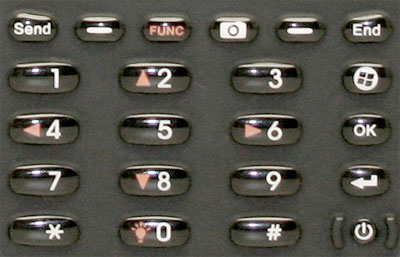 The Getac PS236 is configured as a traditional Pocket PC/PDA but it also has a 22-key keypad for rapid data entry. Instead of a dedicated navigation diamond like in the PS535F, the PS236 has its directional keys as part of the numeric keypad. The Getac PS236 is configured as a traditional Pocket PC/PDA but it also has a 22-key keypad for rapid data entry. Instead of a dedicated navigation diamond like in the PS535F, the PS236 has its directional keys as part of the numeric keypad.
The top row of keys consist of Send/End keys, two soft buttons, the function key, and a key that brings up the camera.
To the right of the numeric keypad is the WIndows key that brings up the Today screen, OK, enter, and the power button.
Above the display are three indicator lights and a small phone-style speaker. A small phone-style microphone is below the keypad.
Operation of the PS236 is via keypad or stylus. Touch works as well, but the Windows Mobile interface is clearly designed for a stylus.
For data entry, the Windows Mobile-based PS236 offers a wealth of options. There is the keyad, there is a nice pop-up keyboard, and three are also no fewer than three different ways of recognizing text. They are:
- Block Recognizer, which uses the special Graffiti alphabet Palm invented in the 1990s. The idea here is that almost all letters are "unistrokes," or consisting of a single uniterrupted stroke, which makes them easy to recognize for the computer. The slightly abstracted alphabet is quite easy to learn. Millions used it on Palm Pilots.
- Letter Recognizer, which also recognizes individual letters instead of whole words, but uses the standard alphabet instead of the slightly modified one of the Block Recognizer. And whereas the Block Recognizer lets you shift case, the Letter Recognizer, which goes back to a product called "Jot" by (CIC) Communication Intelligence Corporation, has different data entry boxes for upper case, lower case and numerals.
- Transcriber, which is a full-function handwriting recognition system that also goes way back almost to the beginning of PDAs more than 15 years ago. Microsoft bought the rights to it a number of years ago and it's been part of Windows Mobile ever since.
Any of those input methods, once mastered, work very well. Below you can see screenshots of the onscreen keyboard, the Block Recognizer, and Transcriber.

For the PS535F, Getac also offers an optional cordless 1D barcode reader and a cordless RFID reader for additional data capture capabilities. We assume those will be available for the PS236 as well.
GPS and mapping
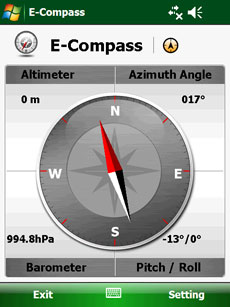 The Getac PS236 has an integrated SiRFstarIII GPS receiver. If it is the same module as the one used in the company's PS535F, it's a 20-channel L1 C/A-code GPS receiver where L1 C/A means it's using the 1575.42 MHz satellite frequency in coarse-acquisition mode. In autonomous mode, accuracy is within five meters. Using differential GPS technology (DGPS) to correct for naturally occuring GPS errors, you can get horizontal accuracy of three to ten feet. That is very accurate and enough for most mapping and GPS applications. Post processing can result in even better accuracy, down to the sub-meter range. The Getac PS236 has an integrated SiRFstarIII GPS receiver. If it is the same module as the one used in the company's PS535F, it's a 20-channel L1 C/A-code GPS receiver where L1 C/A means it's using the 1575.42 MHz satellite frequency in coarse-acquisition mode. In autonomous mode, accuracy is within five meters. Using differential GPS technology (DGPS) to correct for naturally occuring GPS errors, you can get horizontal accuracy of three to ten feet. That is very accurate and enough for most mapping and GPS applications. Post processing can result in even better accuracy, down to the sub-meter range.
The PS236 includes a separate altimeter, is able to determine pitch and roll, probably via an accelerometer, and can also detect barometric pressure. There is an e-Compass (see screen capture from the PS535F on the right) that displays direction as well as altitude, barometer reading, pitch/roll in degrees, and Azimuth Angle. The e-Compass can be set so that either the needle or the wheel rotates, and altitude can be set to GPS or the built-in altimeter.
The pictures below are screenshots from the Getac PS535F. They show the functionality likely included in the new PS236. On the left is the TacLink utility that displays pertinent satellite data. To the right are two screens from Google Maps, a freebie download directly from the web to the device. Google Maps uses the integrated GPS and can show both maps and satellite images. You can locate yourself on the map, and the accuracy was stunning. As I walked around a building, the Getac handheld showed me exactly where I was (and by exactly I mean just that; not in the general vicinity).
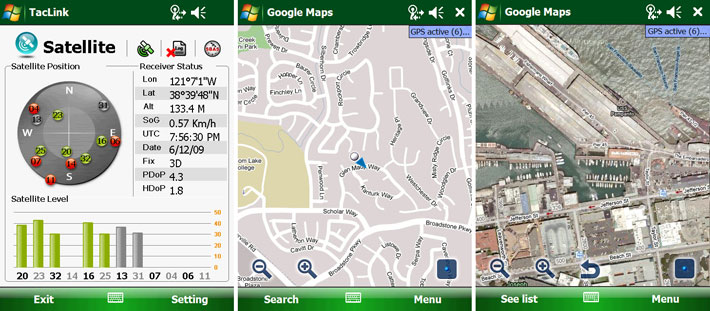
Power
Battery life is always an issue when you're in the field and the next charger is miles away. The 5,600mAH battery used in the PS236 is rated at up to 12 hours between charges, good for full-shift operation and more.
Backlight intensity, backlight shut-off and device shutoff can all be used to optimize battery life. Since Windows Mobile devices are instant-on, it's generally good practice to have the device quickly go to sleep when it is not used. This can greatly extend battery life, though it can also be annoying to have to wake it up all the time.
Ruggedness
The Getac PS236 is an ultra-rugged device and has been tested according to testing procedures described in the new MIL-STD-810G document in all relevant areas (MIL-STD-810G is replacing MIL-STD-810F). The PS236 exceeds the PS535F's ruggedness specs in most areas.
The unit is well protected against damage via rubberized bumpers on the bottom corners and a rubberized endcap on the top. It can handle 4-foot drops, and survived 26 4-foot drops in standarized testing, with the unit on. The PS236 has an extremely wide operating temperature range of -4 to 140 degrees Fahrenheit.
Of most interest to prospective customers is the new model's IP67 ingress protection rating. This is a significant step up from the PS535F's IP54 rating. Whereas IP54 means mostly protected against dust and protected against water spray from all directions, the PS236 is completely sealed against dust and is also totally waterproof, even when immersed in water.
Summary
The speedy Marvell PXA310-powered Getac PS236 is an ultra-rugged handheld GPS computer that offers a well-balanced combination of advanced technology, Pocket PC convenience and targeted professional GIS features. It is running the Windows Mobile 6.1 operating environment, which means it comes with Office Mobile (Word, Excel, PowerPoint), Internet Explorer, email, messaging, calendar, tasks, contacts and all the other goodies most of us have come to rely on. It also has Windows Live, the Windows Media player and a good complement of utilities and security features.
However, this handheld offers far more than just standard PDA functionality. For one thing, it's rugged enough to survive rain, dust, drops and all sorts of abuse, even total immersion in water. It has a 3-megapixel autofocus camera, a GPS receiver, an electronic compass, and an altimeter. Add to that a super-sharp 3.5-inch touch display with full 480 x 640 pixel resolution, 4GB of Flash, a SDHC slot for up to 16GB of additional memory, and you have a device that is ideal for all sorts of GPS, GIS and mapping applications even in extreme environmental conditions.
As for its intended use and application, Getac president Jim Rimay said, "The Getac PS236 offers users fast, reliable, and consistently accurate real-time communications solutions which are critical to anyone working in the field. Our customers work in some of the most extreme environments and need a communications tool that can handle severe climate changes and perform flawlessly. By extending the battery life and increasing the storage capacity in the PS236, our customers can spend more time in the field and increase overall productivity anywhere in the world.""
– Conrad H. Blickenstorfer, September 2009
|
Getac PS236 Specifications
|
| Added/changed |
Added 9/2009
|
| Type |
Ultra-rugged GPS handheld
|
| Processor |
806MHz Marvell PXA310 |
| OS |
Windows Mobile 6.1 Classic or Professional |
| GPS |
SiRFstarIII; 5 meter accuracy autonomous, 1-3 meters SBAS (WAAS/ENGOS/MSAS); post process: sub-meter |
| RAM/ROM |
128MB/4GB NAND FLASH |
| Display |
3.5" 18-bit color transflective TFT with VGA (480 x 640 pixel) resolution and LED backlight |
| Digitizer/Pens |
Touchscreen/1 |
| Keyboard/keys |
22-key keypad |
| Navigation |
4-way directional control and stylus/touch |
| Expansion slots |
1 externally accessible SD/SDHC Card slot (up to 16GB); 1 SIM |
| Housing |
ABS plastic with rubberized bumper areas |
| Size |
3.5 x 7.0 x 1.5 inches |
| Weight |
17.6 oz. as tested |
| Temperature |
-22 to 140 degrees Fahrenheit (MIL-STD 810G, Method 501.4, Procedure II) |
| Ingress Protection |
IP67, IEC 529 MIL-STD 810G, Method 512.4, Procedure I, Water Jet 12.5 mm dia. @ 2.5 - 3m, 100 Liter/min. |
| Drop |
MIL-STD 810G, Method 516.5, Procedure IV 26 drops from 4 ft (1.22 m) 6 additional drops at -22 °F (-30 °C), 6 additional drops at 140°F (60 °C) |
| Vibration |
MIL-STD 810G, Method 514.5 Procedure I |
| Humidity |
MIL-STD 810G, Method 507.4, 90%RH temp cycle 30~60 °C |
| Tumble |
1,000 1.6 ft./.5 m tumbles (2,000 drops) |
| ESD |
estimated: IEC61000-4-2 / EN55024 |
| Regulatory |
estimated: CE, FCC, UL, BSMI, NCC, CCC, SRRC |
| Power |
5,600mAH Li-Ion "up to 12-hour battery life" |
| Communication |
802.11b/g WiFi, Bluetooth Class 2 V2.0 + EDR, 3.0-megapixel camera with LED flash, altimeter, compass; optional integrated 3.5G HSDPA/WCDMA/EDGE/GPRS/GSM WWAN, cordless 1D Barcode Reader, cordless RFID reader |
| Interface |
Mini AB USB OTG (1.2 host, 2.0 client), 9-pin serial, microphone, line-out, power |
Price |
US$1,699; HSDPA model US$2,299 |
| Contact |
Getac us.getac.com -- 1-866-464-3822 |
|
|








